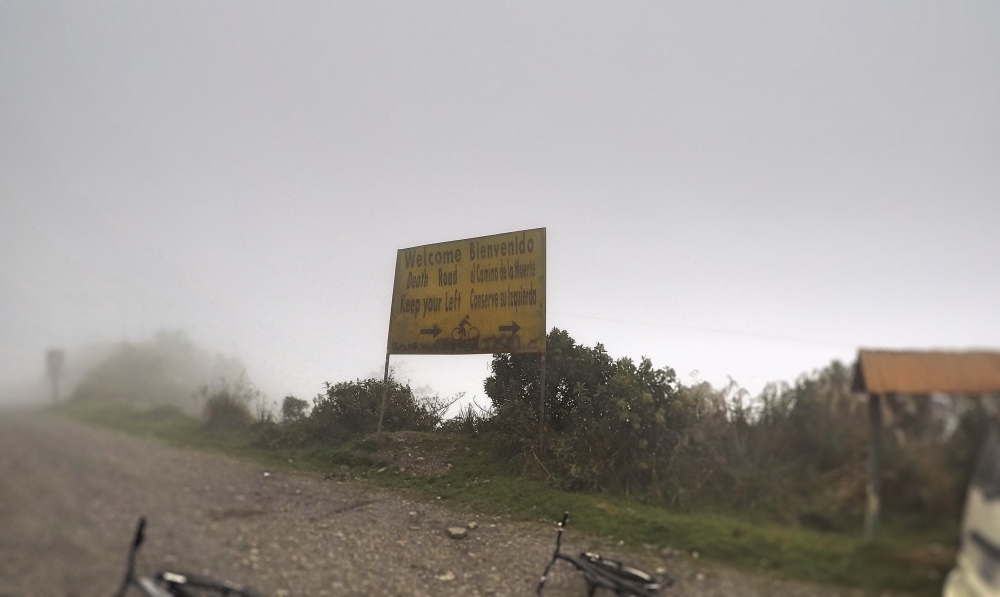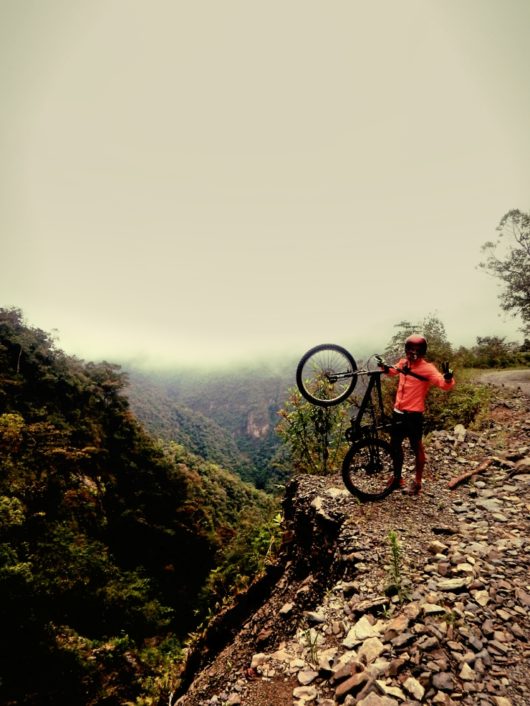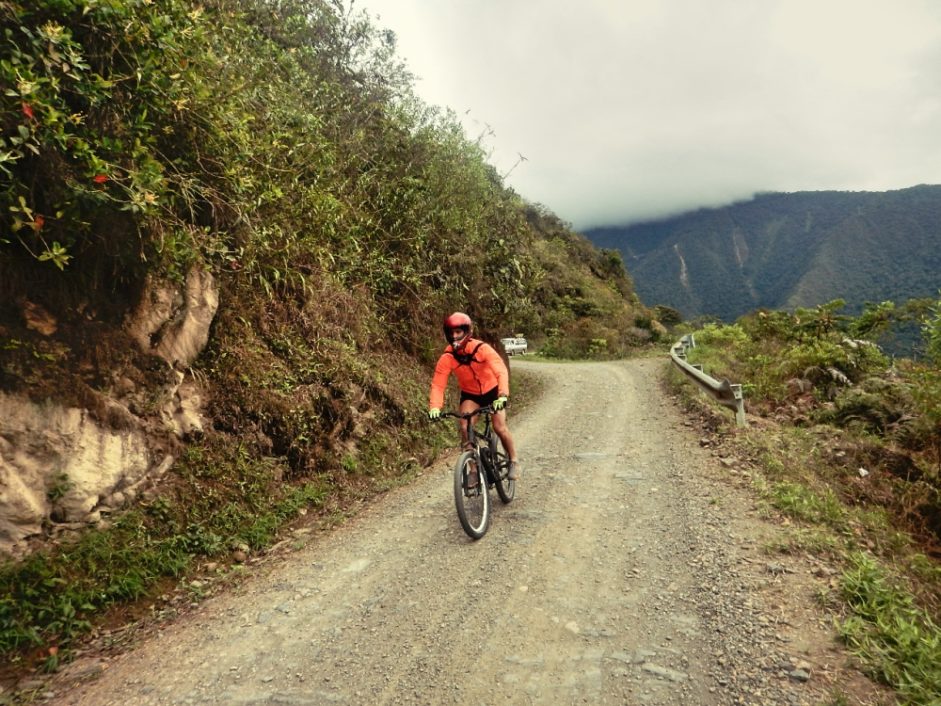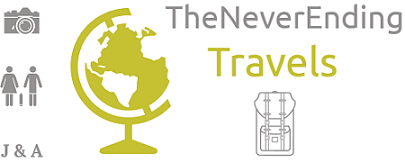Biking down the Death Road
One of the most exciting experience you can have around La Paz is surely test yourself on the “most dangerous road” in the world. Andrea had already had the pleasure to do so in 2015, but it’s so much fun that he couldn’t pass on another adrenaline-fuel day trip.
Facts
The North Yungas Road was named in 1995 as the “world’s most dangerous road”. It connects La Paz to Coroico along 56 km of unpaved road. The South Yungas Road (newer) is still considered to be nearly as dangerous as the North Road and connects La Paz to Chulumani over 64km. In 2006, one estimate stated that 200 to 300 travellers were killed yearly along the road.

The road starts at 4650 msl at La Cumbre Pass, before descending to 1200 ms, letting you experience a 3400 meter drop, passing from snowy mountains to subtropical jungle climate.
Most of the road is the width of a single vehicle and rain and fog can severely hamper visibility, and water runoff can turn the road into a muddy track, affecting traction. Unlike the rest of Bolivia, vehicles are required to drive on the left side of the road to give the driver a better view of the vehicle’s outside wheel and making passing safer.
Today it’s mostly a touristic attraction, but nevertheless it is a dangerous road. At least 18 cyclists have died on the road since 1998.
How to book it?
In central LaPaz you will find every single travel agency, hostel, even restaurants, offering daily tours to the Death Road. The prices vary quite a lot depending on 2 factors: bike type & and agency quality/popularity. The day trip can cost you anything from 250 bolivianos (30€) to 1200 bolivianos (125€)
No matter which agency you turn too, they will offer you 3 different price levels according to what type of bike you want to use. The cheapest being a single suspension mountain bike, to get to expensive brand-new, full suspension, hydraulic brake, beauty on 2 wheels.
The more popular a Tour Agency is, the more it will cost you. But what will be be the difference? The most famous agencies are Barracuda, Gravity and Altitude. They come will full English guides, dedicated lunch menu, newer bikes and better equipment (nice uniforms, newer protections).
On the other hand you can walk the streets around The Witches Market and you will find plenty of small agencies offering the tour. With them you will have older bikes, not so out-of-a-magazine uniforms and the lunch take place at a common dining area.
Every agency (famous or family-run) will still offer you a commemorative t-shirt, photos and videos of the event (the guide take pictures throughout the day) and the food quality difference is minimal.
There is no need to book in advance as tours leave every day and there is always room with one agency or the other.
How to choose an agency?
How to choose then? Andrea tried one of the best rated agencies in 2015 and went with a small local agency this year, so let’s hear what he recommends.
If you have never tried mountain biking, then I would suggest you to go with one of the top rated agency, simply because with newer bikes and equipment (that you must wear at all the time, no matter if it’s 30 degrees) you will fell safer. Also, the group movements are guided meticulously. Everyone will stop every 5 minutes to take pictures but also to regroup. This surely is reassuring for the slower bikers, but it’s a bit of a turn off for the more experience cyclist. You always have to follow behind the tour leader and stop very often to wait for the others. Forget about bargaining the price with such agencies.
If you feel confident on 2 wheels and/or you have done already similar downhills, then I would totally recommend you to scout for a small local agency. First of all, you will save quite a lot of money (you can also bargain), secondly you will be more free. I wasn’t forced to wear uncomfortable protective gear, or pants, or jackets (if you want to they have it, no worries) and I could speed down as much as I liked and wait for the others whenever I felt like. I found this very pleasing and I’m sure other experienced bikers would feel the same.
How does it work?
the program is exactly the same with every agency. They pick you up between 7:00 and 8:00 and after 1h drive you reach the starting point at 4600 msl. There you get your gear and bikes, plus an exhaustive briefing on the road itself and the safety instructions.
The first 20km or so are on the newer fully paved road (although there is a plethora of holes in the asphalt) that reminds a lot the alpine roads that drive through North Italy. After a check-point where you need to pay 50 bolivianos for accessing the infamous Yunga you will start the older part of the “carretera de la muerte”. There is also a lot of fog and usually rain at the beginning of it, so do not be afraid. Visibility is really short, but you will go slowly here.
The next 20km or so are the most exciting, as they feature a vertical descend on unpaved road full of rocks, cliffs and dangerous turns. The last 20km of the track are less vertical, but they allow you to take more speed and hit some cool jumps, if you feel like.
The biking part ends at Yolosa around 1pm, where you are served lunch and you can rest in a lodge or camping. Driving back to La Paz takes 3hours, so get ready for a nice sleep and bring a change of clothes because you will be totally wet at the end of the downhill.
Don’t miss Andrea’s Video!
In bici sulla strada della morte
Una delle escursioni più adrenaliniche in cui cimentarvi nei dintorni di La Paz è sicuramente lanciarvi in bici sulla “strada più pericolosa al mondo“. Andrea aveva già provato questa esperienza nel 2015, ma non poteva farsi sfuggiare l’occasione di passare un’altra giornata spericolata.
Informazioni Principali
La North Yungas Road è stata nominata ufficialmente come “strada più pericolosa al mondo” nel 1995. Collega La Paz a Coroico tramite 56 km di strada sterrata. La South Yungas Road (la nuova versione) è comunque considerata quasi pericolosa come la originale. Nel 2006 uno studio ha estimato che ogni anno muiono su queste strade tra i 200 e 300 viaggiatori.
La strada inizia in cima al passo La Cumbre a 4650 metri di altitudine e scende fino a 1200mt; si passa da cime innevate ad un clima tropicale nella giugla attraverso una discesa con un dislivello di 3400mt.
La maggior parte della carreggiata non è più ampia di un singolo veicolo e la nebbia affusca molto spesso la visibilità. Inoltre le pioggie regolari trasformano la strada in un fanghiglio scivoloso. Al contrario del resto della Bolivia, su questa strada si viaggia a sinista in modo da dare una migliore visuale del precipizio al conducente.
Oggigiorno è diventata un’attrazione turistica, ma rimane comunque una strada periocolosa. Almeno 18 turisti sono morti su questa strada dal 1998 ad oggi.
Come prenotare il tour?
In centro a La Paz ogni singola agenzia di viaggio, ostello, e perfino molti ristoranti vi offriranno ogni giorno escursioni per la Death Road. I prezzi variano di molto e dipendono da 2 fattori: il tipo di bici e la popolarità/qualità dell’agenzia. Questa giornata all’insegna del divertimento vi può costare qualsiasi prezzo tra i 250 bolivianos(30€) ed i 1200 bolivianos (150€)
Ogni agenzia avrà 3 (o più) modelli di bici tra cui farvi scegliere. La più economica una semplice mountain bike a sospensione singola, fino ad arrivare a bici nuove di zecca con doppia sospensione e freni idraulici.
Più una agenzia è famosa, più alti standard di qualità avrà ed ovviamente sarà più costosa. In cosa consiste questa maggiore qualità? Le agenzie più rinomate sono Barracuda, Gravity e Altitude. Con loro avrete sempre guide che parlano un ottimo inglese, pranzo in una struttura dedicata e soprattutto bici più nuove ed equipaggiamento migliore.
L’opzione opposta è recarsi nella zone del Mercato delle Streghe e rivolgersi ad una delle agenzie locali più piccole. Con loro avrete bici più vecchie, equipaggiamento senza fronzoli ed il prazo avviene in un area comune con le altre piccole agenzie.
Tutte le agenzie (care od economica che sia) vi regaleranno una maglietta commemorativa e foto e video di questa giornata speciale (la guida vi farà foto tutto il tempo) e la differenza nella qualità del cibo è minima.
Non c’è bisogno di prenotare in anticipo visto che ogni giorno ci sono tour pronti a partire, sempre pronti ad accogliere un nuovo avventuriero.
Quale agenzia scegliere?
Andrea nel 2015 si è rivolto ad una delle agenzie più famose, mentre questa settimana ha scelto una piccola agenzia locale. Ecco i suoi consigli su come scegliere il tour più adatto a voi.
Se non avete mai fatto mountain bike prima, allora vi consiglio caldamente di rivolgervi ad una delle agenzie più rinomate, semplicemente perchè con una bici ed un equipaggiamento nuovo (che dovrete indossare per forza, sempre, anche con 30 gradi) vi sentirete più sicuri. Inoltre il gruppo viene guidato in maniera scrupolosa dalla guida: tutti si fermano ogni 5 minuti per fare foto e per riunirsi. Questo è sicuramente un vantaggio per i meno avventurosi, ma è un po’ noioso per i ciclisti più esperti. Dovrete sempre seguire e stare dietro alla guida ed aspettare gli altri. Non c’è possibilità di negoziare il prezzo con una agenzia di prima fascia.
Se invece siete sicuri di voi sulla bici e/o avete già fatto discese in fuoristada, allora vi consiglio di scegliere una piccola agenzia. Prima di tutto risparmiere parecchio (i prezzi sono contrattabili), inoltre sarete più liberi di godervi la giornata. Non ho dovuto indossare nessuna protezione fastidiosa o divisa ingombrante (se volete proteggervi ve le danno, non preoccupatevi!) e sono potuto scendere alla velocità che più mi garbava e fermandomi quando volevo. Mi sono goduto la giornata molto di più così!

Cosa vi aspetta?
Il programma è uguale con qualsiasi agenzia. Vi passeranno a prendere tra le 7 e le 8 del mattino e dopo un breve viaggio di circa 1 ora arriverte al punto di partenza a 4650 mt. Lì vi sarà assegnata la vostra bici e vi verranno date tutte le informazioni sulla strada e sulla sicurezza.
I primi 20 km circa sono sulla parte nuova della strada, asfaltata (anche se con molte buche) che ricorda molto i passi alpini del nord Italia. Dopo un check-point dove dovrete pagare 50 bolivianos entrerete ufficialmente nella rinomata “carretera de la muerte”. C’è sempre molta nebbia in questo punto, non fatevi spaventare. Anche se la visibilità è davvero limitata non andrete a velocità elevate in questo tratto.
I 20 km centrali sono i più divertenti, con una discesa verticale su strada sterrata e piena di sassi, curve a gomito e precipizi senza fine. Gli ultimi 20 km sono più facili da un punto di vista tecnico, ma si può andare più veloce ed anche fare qualche bel salto.
Il tour in bici finisce a Yolosa verso le 13:00 dove potrete riposarvi e vi sarà servito il pranzo in un lodge o camping. Il ritorno a La Paz è lungo ben 3 ore, per cui preparatevi ad una bella dormita. Portatevi anche una maglietta di ricambio perchè sarete fradici all’arrivo.

No Comments